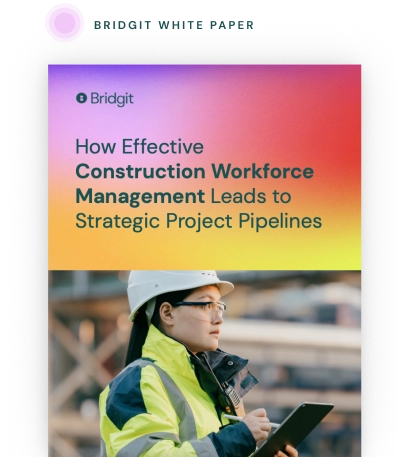One of the most difficult problems in construction is the tension between short-term and long-term planning, especially regarding the workforce. It’s also a paradox since so many construction projects span a number of years, yet it’s difficult to plan your workforce effectively despite the large intervals of time projects take up.
It doesn’t mean that short-term planning is easier, it’s just more common because reactivity in construction has become the norm. It’s easy to see why reactivity is so common, construction companies have to deal with numerous complex and dynamic variables. Some of these variables include: selecting the right kind of projects to bid on, determining the profitability of a project, due diligence, mitigating risks, predicting the cost of materials and labor, and finding reliable subcontractors for a job.
Table of Contents
With so many variables to handle, being able to plan your workforce effectively in both the short and long term is a luxury, not necessarily mandatory. Yet, your people are at the heart of project delivery, and if they’re not organized well project deliverability will inevitably suffer.
Let’s look at some statistics that point to the fact that effective short and long-term planning of your workforce isn’t a luxury, but a necessity. In a survey done by Bridgit, 70% of GCs said they allocate staff to projects less than two months in advance and 46% said they don’t have enough time to hire staff when the project needs it. In the same survey, 86% of respondents said they’ve bid on projects only to find they don’t have the proper workforce to complete the job.

Use your workforce data to create a competitive advantage
Download our white paper to see how effective workforce planning can help stay ahead of labor demands and create a strategic project pipeline.
These statistics illuminate a few key things. Firstly, there’s the cost of being uninformed about labor before a project even starts. A project bid has a cost whether it’s won or lost and you’ll only incur more costs if you find that you don’t have enough labor when the project is actually underway.
Secondly, the lack of proactivity when it comes to workforce management is a pervasive problem in construction. This is because the vast majority of GCs are using systems like spreadsheets and whiteboards to plan their workforces. The main limitation of these kinds of tools is that they can’t provide dynamic visibility into short and long-term scenarios regarding your people, making you reactive almost by accident.
Thirdly, ineffective workforce management compounds. As work piles up, GCs have to rush, leading to mistakes like bad hires or increased costs from project delays because you have to pull labor from one job to another. Add labor shortages into the mix and the costs and stress intensify.
Improvement is possible
It should be clear at this point that effective short and long-term workforce planning is a key variable in successful project delivery, or at the very least, that reactive workforce planning is a hindrance to successful project delivery.
What can be done to fix this hindrance? The first step is understanding that your current tools for workforce planning have glaring limitations. The limitations around spreadsheets are:
- No continuity and collaboration is difficult since one person or small group owns the process.
- Human error. Research from Raymond Panko, of the University of Hawaii, suggests that 88% of spreadsheets have significant errors on them that won’t indicate an error. This means that you’re simply using bad data and trying to make important decisions based on it.
- Poor visibility into data. You want to be able to use your workforce data to instantly see where a new project can fit in your pipeline and the impact it’ll have on your workforce. You also want to see the impact of any changes you make with current projects in order to see how it’ll affect day-to-day operations and staff allocations.
These problems can be solved collectively by adopting a workforce management tool. A tool like Bridgit Bench gives you a comprehensive picture of your workforce in the short and long term.
Short-term adjustments are simple and all your people and project data are updated in real-time. It’s important to be agile but it’s also important to make good decisions. In a workforce planning tool, the data you’re using is adjusted in real time and accurately, assuring quickness and quality.
Making better decisions long-term
We’ve outlined how short-term decision-making can improve, but the elusive mystery in construction is if long-term people planning is possible, and if it is, how effective can the process be with so many dynamic variables?
You can think of long-term workforce planning in two ways:
- Real project plans. These include two main activities: Pursuit planning and recruitment.
- Long-term company vision for your people. This includes filling skills gaps by creating development opportunities for your employees and overall training so your people are appropriately challenged and evolving in their roles.
Real project plans
Construction workforce management tools give you the ability to plan your workforce around project pursuits, something many GCs aren’t currently doing. Planning for pursuits gives you the power to predict if you’ll have enough capacity to take on a new project. This can help you save on bidding costs because you won’t go after projects you can’t take on. The inverse of that is true as well, you can see that you have additional capacity and can bid on projects more aggressively.
The benefits of planning for pursuits help inform your HR team as well. They can access the workforce planning tool and easily see where labor capacity is limited in terms of specific roles and projects. If they see that they need superintendents and carpenters for projects coming up a year from now, they’ll have a lot of time to create a strong recruitment strategy.
Planning for the long term this way helps curtail the costs of poor project bids and employee turnover. The latter is a major cost in the construction industry according to Busy Busy, with turnover costs for complex jobs like engineers being 213% of their yearly salary. The construction industry already has low employee retention, so every dollar that can be saved goes a long way.
Long-term vision
Every construction company should know where they’re going in the wider industry landscape. A key question in that wider purpose is where are the people in this company going. If you can determine the answer to that question, you can probably determine the long-term fate of your company.
Once the actual strategy and tactics of your short and long-term workforce planning are systematized and implemented, you could use those same tools to help you shape a talent development plan so you know your people are evolving their skill sets. This can also help you mitigate against skilled labor shortages since you’ll be developing the exact skill shortage you’re facing.
With construction workforce management tools you can track the experience, certifications, education, and historical performance of individual employees. By tracking these employee attributes you can develop individualized plans for employee growth.
Employees can gain job skills by being paired with more senior team members. This way one can learn on-site skills and the other can sharpen their leadership capabilities.
You can even take this to the next level by using these insights to drive a culture of long-term growth at your company. Ryan Companies is an example of a construction firm attempting to make day-to-day training and long-term professional development a seamless experience. As this culture takes shape in your company, retaining and attracting employees will be easier. This is especially relevant as the aging construction workforce retires.
Think your workforce planning meetings could be more productive?
Download our ebook to learn how to run efficient, effective workforce planning meetings with your team.



